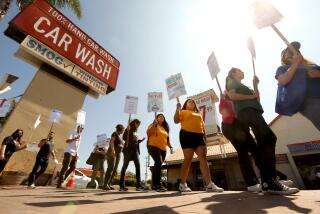State Blamed for Workers’ Comp Crisis
- Share via
SACRAMENTO — A government report released Wednesday lays much of the blame for California’s workers’ compensation crisis at the feet of state officials, concluding they ignored repeated warnings that the system was spiraling out of control.
The 153-page report from the independent state auditor comes as the Legislature struggles to overhaul a workers’ comp system that has sent employers’ costs ballooning from $9 billion in 1995 to an estimated $29 billion this year.
The system’s disrepair is an urgent concern for employers, from restaurant owners to city governments, and has become fodder for the candidates angling to replace Gov. Gray Davis in the Oct. 7 recall election.
Lawmakers say they hope to draft a comprehensive package of reforms within the next two weeks.
“The system is totally out of control,” state Insurance Commissioner John Garamendi said Wednesday at a news conference. “It ranges from an outright disaster to a serious job-creation issue.”
Although the system’s woes have been traced to deregulation in the mid-1990s that led to price wars, as well as to other factors such as abuse and fraud, the report says the state could have taken measures to control the rising cost of treating injured workers.
In the report, requested by the Legislature several months ago, State Auditor Elaine M. Howle blames state officials for failing to set caps on what insurers pay for medical services or the number of visits injured workers may make to doctors, physical therapists, chiropractors and others.
“In spite of abundant available research, the state has not taken steps to ensure that injured workers have access to quality care at a reasonable cost to employers,” the report says. “Medical costs are rising in the workers’ compensation system because the state has done a poor job of containing costs in a system in which employers have no choice but to pay those costs.”
All employers in California are required to carry workers’ comp coverage, which provides a safety net for more than 14 million workers if they are injured on the job.
Richard P. Gannon, administrative director of the Division of Workers’ Compensation within the Department of Industrial Relations, defended the agency’s work and said many reforms being considered originated in his office.
Gannon said his mandate in 1999, when he was appointed by Davis, was to streamline the process for settling disputes over care and payments. Cost containment, he said, wasn’t the pressing issue it is today.
“Everyone’s costs increase while there’s a delay in resolving disputes,” he said, adding that budget cuts and hiring freezes have limited what the division can do.
The situation has reached crisis proportions, business owners say. At the news conference with Garamendi Wednesday, Jim Sinegal, chief executive of Costco Wholesale Corp., called the system “bad, unjust and corrupt.”
The retailer operates in 36 states. Seventy percent of its workers’ compensation costs nationwide come from California, even though only a third of its employees work in the state, Sinegal said.
He said Costco would soon ask its 10 million California members to sign petitions demanding the Legislature reform the system.
If nothing is done quickly, Garamendi said, the State Compensation Insurance Fund, which provides workers’ compensation insurance to more than half the employers in California, could raise premiums 12% in January. That would be on top of an average increase of 19% that went into effect in July.
Employers took their complaints Wednesday to lawmakers meeting for the second day as members of a workers’ compensation conference committee. It plans to sift through dozens of bills and find a way to bring down the cost of workers’ comp insurance before the Legislature adjourns Sept. 12.
Davis has promised to sign reform legislation. He and Garamendi suggest capping payments to outpatient surgery centers and tying fees for other medical services to a schedule used by the federal Medicare system. They also seek greater use of generic drugs, better training for workers’ comp claims handlers and the creation of a method to resolve disputes outside the Workers’ Compensation Appeals Board.
According to Wednesday’s report, the cost of a typical medical claim by an injured California worker is similar to that in other states, but the number of treatments far exceeds the average.
Injured workers in California have 49% more visits with doctors and 105% more chiropractor visits than hurt workers in other states, according to a study by the Workers’ Compensation Research Institute.
State auditors found a similar pattern in their review of medical claims. They found that “the recent increases in medical costs stem more from the increase in the number of medical services” than from the prices paid for those services.
According to the report, payments to chiropractors increased 126% from 1995 through 2002, outpacing the rise in overall medical costs.
On Tuesday, hundreds of chiropractors rallied at the Capitol to oppose a proposed 15-visit cap on chiropractic care for injured workers.
More to Read
Get the L.A. Times Politics newsletter
Deeply reported insights into legislation, politics and policy from Sacramento, Washington and beyond. In your inbox twice per week.
You may occasionally receive promotional content from the Los Angeles Times.










